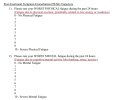Post-Exertional Symptom Exacerbation after Sub-Maximal Exercise in Individuals with Myalgic Encephalomyelitis/Chronic Fatigue Syndrome and Post-Acute Sequelae of COVID-19
Berardi, Giovanni; Janowski, Adam; McNally, Samuel; Post, Andrew; Garg, Alpana; Sluka, Kathleen A.
[Line breaks added]
Purpose
In individuals with myalgic encephalomyelitis/chronic fatigue syndrome (ME/CFS) and post-acute sequelae of SARS-CoV-2 infection (PASC), physical activity can exacerbate symptoms for days-to-weeks, referred to as post-exertional symptom exacerbation (PESE).
This study characterized the trajectory of PESE symptoms before and for 7 days after a sub-maximal exercise task in individuals with ME/CFS or PASC.
Methods
Individuals with ME/CFS (n=30) or PASC (n=30) and matched controls (n=30) were recruited from a university hospital and the community setting. Participants completed a 25-minute moderate intensity exercise on a whole-body cycle ergometer.
The trajectory of 8 commonly reported PESE symptoms (physical fatigue, mental fatigue, pain, physical function, flu-like symptoms, gastrointestinal symptoms, sleep dysfunction, anxiety) before and for 7 days after exercise.
Results
There was variability in the proportion of those who experienced increased symptoms ranging from 46/60 reporting physical fatigue to only 18/30 reporting anxiety. There was no change in any of the symptoms across the 7-day period when analyzed individually.
An aggregate score of 4-5 symptoms that includes physical fatigue, mental fatigue, physical function and flu-like symptoms, with or without pain, was more comprehensive in capturing maximal changes in PESE. Changes were greatest during the 72h post-exercise and for those with ME/CFS.
The aggregate score shows 8/30 of individuals with ME/CFS and 12/30 with PASC show minimal-to-no increase in PESE, while 6-7/30 show increases greater than 3/10 points.
Conclusions
PESE to a clinically relevant exercise task is variable in individuals with ME/CFS and PASC as submaximal exercise does not exacerbate symptoms for some, while modifications of intensity may be necessary to minimize PESE in others.
Web | Medicine & Science in Sports & Exercise | Paywall
Berardi, Giovanni; Janowski, Adam; McNally, Samuel; Post, Andrew; Garg, Alpana; Sluka, Kathleen A.
[Line breaks added]
Purpose
In individuals with myalgic encephalomyelitis/chronic fatigue syndrome (ME/CFS) and post-acute sequelae of SARS-CoV-2 infection (PASC), physical activity can exacerbate symptoms for days-to-weeks, referred to as post-exertional symptom exacerbation (PESE).
This study characterized the trajectory of PESE symptoms before and for 7 days after a sub-maximal exercise task in individuals with ME/CFS or PASC.
Methods
Individuals with ME/CFS (n=30) or PASC (n=30) and matched controls (n=30) were recruited from a university hospital and the community setting. Participants completed a 25-minute moderate intensity exercise on a whole-body cycle ergometer.
The trajectory of 8 commonly reported PESE symptoms (physical fatigue, mental fatigue, pain, physical function, flu-like symptoms, gastrointestinal symptoms, sleep dysfunction, anxiety) before and for 7 days after exercise.
Results
There was variability in the proportion of those who experienced increased symptoms ranging from 46/60 reporting physical fatigue to only 18/30 reporting anxiety. There was no change in any of the symptoms across the 7-day period when analyzed individually.
An aggregate score of 4-5 symptoms that includes physical fatigue, mental fatigue, physical function and flu-like symptoms, with or without pain, was more comprehensive in capturing maximal changes in PESE. Changes were greatest during the 72h post-exercise and for those with ME/CFS.
The aggregate score shows 8/30 of individuals with ME/CFS and 12/30 with PASC show minimal-to-no increase in PESE, while 6-7/30 show increases greater than 3/10 points.
Conclusions
PESE to a clinically relevant exercise task is variable in individuals with ME/CFS and PASC as submaximal exercise does not exacerbate symptoms for some, while modifications of intensity may be necessary to minimize PESE in others.
Web | Medicine & Science in Sports & Exercise | Paywall



